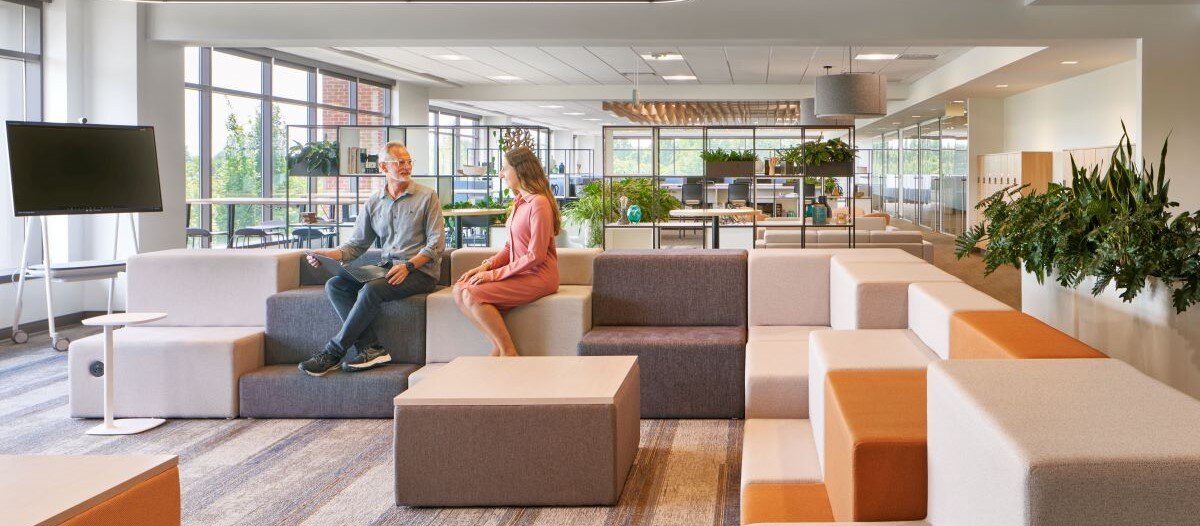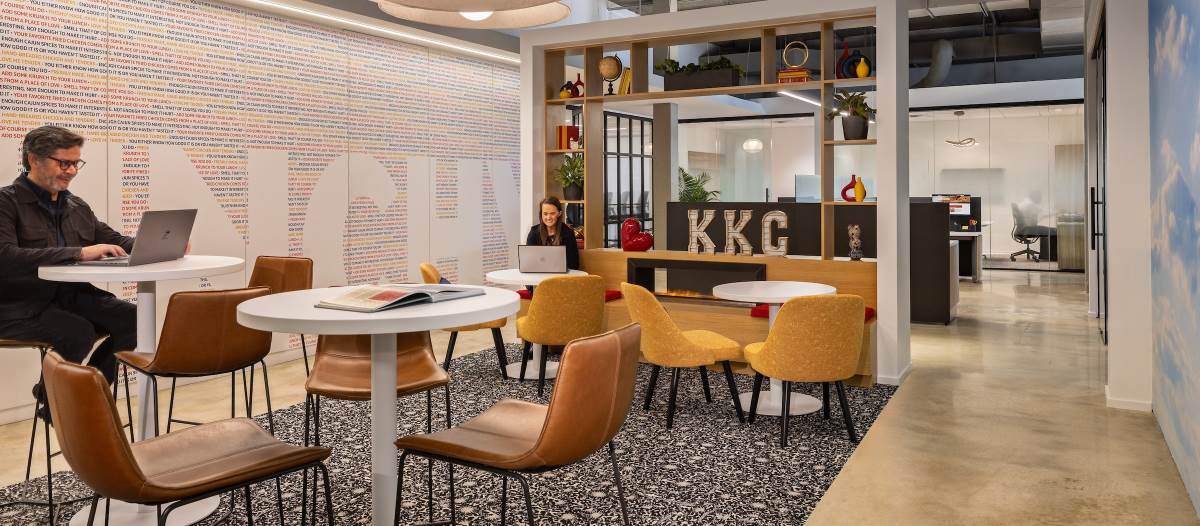The (Home-like) Office of Tomorrow
Bridging work & comfort

Half of workers across the world are back in the office four or more days per week, according to Returning for Good, a recent Global Workplace Insights report from Unispace, and that number is growing. Globally, hybrid is the most common model for companies.
As employees and employers around the world adjust to evolving work paradigms, the traditional office is increasingly being reshaped to incorporate home-like amenities. The workflow has grown used to the flexibility and comfort provided by a remote or hybrid workplace and expect similar experiences in the physical environment. Many companies are finding that “homified” office spaces offer new opportunities for staff collaboration and innovation.
In the era of digital dominance, designing the office of the future means creating purposeful work environments. While the offices of the past have typically followed traditional corporate etiquette, the next wave of workplace design transcends functional considerations to reflect upon how work from home (WFH) dynamics have shifted human priorities and productivity. As a result of the new attention paid to how and where people work best, the next generation of offices may resemble the main living space in a home more than the cubicle farms of yesteryear.
The office will never be a home environment, but it is fast becoming a realm that exudes familiarity, inspiration and inclusivity. A truly homified office should not only match the benefits of WFH but expand upon them, creating an innovative and collaborative space where everyone feels welcomed and included.
Inspire with innovation spaces
While working from home has many advantages, innovation takes a backseat when a workforce is isolated from one another. According to the Returning for Good report, 69 percent of employees indicated they prefer brainstorming sessions to be in-person and 62 percent would like to have one-on-one in-person meetings with their supervisor.
As it is easier to collaborate in-person, the office offers a distinct advantage when it comes to freeform ideation and brainstorming. Many companies are supporting creativity and connection through open collaboration areas for impromptu meetings. Integrated technology, flexible furniture and moveable whiteboards allow employees to use these spaces for different tasks and projects. By designing spaces with their employees needs in mind, leaders can elevate productivity and satisfaction.
Partitioning departments into flexible activity zones, new on-site office can have different space types and features to support teams’ functions. This includes innovation areas for brainstorming, banquet rooms for seamless virtual meetings, and multiuse spaces for entertaining and socializing. This office empowers employees to connect with each other, remotely or in-person.
The connection between choice & productivity
Designing a workplace that is tailored to employees diverse needs is critical. What may work for one employee, may not for another. Providing different space types for tasks can improve employee satisfaction and encourage them to want to come into the office.
Top concerns from employees about returning to the office as indicated in Returning for Good include not having the quiet space to do heads down work, missing the privacy of home, and not feeling as productive as they do when working remotely. Globally, 31 percent of employees said their top office dislike was the lack of privacy.
Employees in India, for example, are more likely than any other country globally to be willing to take a pay reduction to work from home, with almost a third indicating that they have already done so. This is almost double the global average of 16 percent. These numbers highlight a need to give employees options regarding where they can complete focus work in the office.
Embracing technology: A game changer for progress
Inconsistent Wi-Fi stands out as one of the major challenges faced by workers. Paradoxically, according to the Unispace global workplace insights report, strong internet connectivity emerged as the most coveted office amenity for global employees (45 percent), followed by a well-equipped tech set up (39 percent), and access to natural light suitable for video calls (33 percent). Commuting to the office only to only to have connectivity issues or not have access to needed accessories causes frustration and impacts productivity. As companies require employees to come back into the office, having working technology is essential.
Make amenities equitable
%20Office%20of%20Tomorrow.jpg?width=200&height=200&name=FMJ%20Extra%20-%20The%20(Home-like)%20Office%20of%20Tomorrow.jpg) While quality office coffee can motivate employees to come back to the workplace, these types of requisite perks aren’t the main drivers of the great office experience. Along with enhanced spaces for focus and collaboration, many offices now include wellness rooms, game areas and gender-neutral restrooms as ways to provide home comforts in the office.
While quality office coffee can motivate employees to come back to the workplace, these types of requisite perks aren’t the main drivers of the great office experience. Along with enhanced spaces for focus and collaboration, many offices now include wellness rooms, game areas and gender-neutral restrooms as ways to provide home comforts in the office.
More than half (53 percent) of global employees surveyed indicated their workplace does not provide access to areas for respite, which may contribute to increased employee burnout. Adding wellness rooms or spaces to recharge that can accommodate medical needs, meditation, yoga, and mental health breaks helps to tackle this issue. Companies that prioritize wellbeing have higher employee satisfaction and loyalty. For example, U.S. employees also indicated free lunch options (83 percent) and paid travel (82 percent) would encourage them to want to come into the office more.
These trends are seen on a global scale as well. In Hong Kong, 73 percent of employees believe they should receive incentives to return to the office, while in Singapore, 91 percent want to go into a workplace that offers complementary lunch options.
Bridge the generational gap
One of the most surprising findings from Returning for Good was the willingness of Gen Z and younger millennials to come into the office. Seventy-nine percent of global employees ages 18-34 say they expect to be in the workplace four days a week, while 67 percent of those ages 35-44 and 51 percent of employees over the age of 45 share these expectations.
When technology works, younger workers are embracing the camaraderie and fun elements of the workplace. Older generations, who have become accustomed to their home environments are more reluctant to come into the office. Forty-eight percent of employees globally currently hot-desk when in the office, and of these employees who hot-desk, 83 percent would be more inclined to come into the office if they had an assigned desk. Offering a range of flexible workplace options that empower employees to find an arrangement that fits their needs for socialization and quiet time provides a happy medium to satisfy different generations.
Show some personality
Bringing in branding, biophilia and natural elements, and connections to the community and company can connect employees to the company culture. For example, bringing in impactful artwork can remind employees why they love the company that they work for.
Empower employees by listening & delivering
While there is no one size fits all, there are ways to bridge the gap to make sure employees’ needs are being met. Consider what employees want in their workplace. Provide incentives to build loyalty and consider ways the company can make investments to tailor their workplace to be purposeful. The more comfortable employees feel comfortable and inspired, the more likely they are to want to come into the office.

Read more on Occupancy & Human Factors , Real Estate and Workplace
Explore All FMJ Topics









